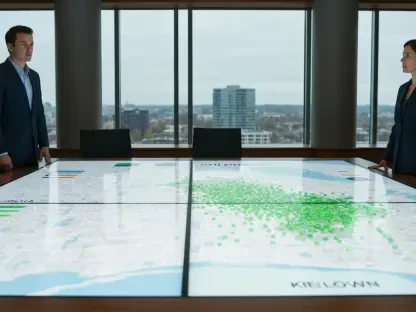The Washington Bridge’s emergency closure in December 2023 sparked a fierce legal confrontation between the State of Rhode Island and several contractors. The state alleges negligence on the part of these contractors, who were entrusted with the inspection, design, and maintenance of the bridge. This negligence is said to have contributed to the bridge’s significant deterioration, necessitating the sudden and dramatic shutdown. The unfolding legal proceedings aim to determine the extent of responsibility shared among these contractors and reinforce accountability in maintaining vital infrastructure.
Unraveling the Allegations
Detailed Interrogatories and Document Requests
At the core of this lawsuit are the intricate interrogatories and voluminous document requests that the Attorney General’s office has directed at the contractors involved. These are not merely routine inquiries; they are essential instruments the state uses to uncover the truth about what the contractors knew about the bridge’s condition and the decisions they made—or neglected to make—regarding its upkeep. The questions delve into the technicalities of bridge maintenance, focusing on the integrity of key structural components such as the post-tensioning cables and the condition of the concrete grout. Each query serves not only as a tool for fact-finding but also as a mechanism to assign accountability for the structural failures observed on the Washington Bridge. By systematically exploring these specifics, the state seeks to construct a clear narrative of neglect, if any, and potential contractual breaches.
The attorneys are particularly focused on understanding whether the contractors were already aware of the issues that eventually led to the bridge’s closure and whether they took adequate steps to address them. Reports had previously identified significant concerns, such as corroded tendon anchors and voids in the grout, which pointed to underlying vulnerabilities. The state’s legal team is intent on establishing whether such warning signs were missed or ignored. Did the contractors fully comply with their obligations, both express and implied, as required by their agreements? Overall, the legal strategy employs these detailed inquiries as a means to manifest lapses in oversight, painting a picture of potential negligence that compromised the bridge’s integrity.
Technical Complexities and Contractual Duties
The technical complexity of the bridge’s design cannot be understated, with the post-tensioned structure designed for enhanced resilience. However, deficiencies identified in the inspection reports cast doubt on the integrity of the structure. These technical challenges are central to dissecting the contractors’ responsibilities and whether they sufficiently understood the structural risks involved. The state’s lawsuit posits that issues such as the presence of voids in grout and flawed concrete were red flags that required immediate attention, yet may have been overlooked, thereby compromising safety. By drawing upon engineering standards and bridging them with legal obligations, the state seeks to demonstrate that the contractors failed to deliver on their contractual promises adequately, both in word and spirit.
The state’s attorneys are methodically juxtaposing the observed structural shortcomings against the contractors’ historical records, attempting to align actions or inactions with suspected breaches of contract. This inquiry sharpens the narrative of potential professional oversight or neglect. As part of developing its argument, the legal team is expected to highlight the expectations laid out in the contractors’ agreements, exploring critical areas where expectations may not have matched delivery. Beyond the legal consequences, the outcome of this process bears significant implications for public safety and infrastructure reliability, urging a reevaluation of how such projects are managed and held to account in the future.
Contrasting Legal Narratives
Contractors’ Defense and State’s Pursuit
The legal defense mounted by the contractors features significant resistance to the state’s claims. They describe the lawsuit as overly broad, likening it to a “fishing expedition” designed more to cast aspersions than to resolve facts. This characterization portrays a narrative of a legal challenge grounded in specific motivations rather than merit. The contractors argue that the state’s demands for information exceed reasonable expectations and seem geared towards assigning blame indiscriminately rather than assessing fault accurately. Such arguments are a core component of the broader defense strategy aimed at countering the weight of the state’s allegations and presenting their actions as compliant within the scope of their contracts.
In contrast, Rhode Island’s persistent pursuit of transparency and accountability underscores its commitment to excavating the full extent of what transpired. By insisting on comprehensive responses and precise documentation from the contractors, the state aims to clarify the chain of events that led to the bridge’s deterioration. Despite the contractors’ pushback, the judiciary’s choice to allow the case to proceed reinforces the perception of grounding. Judge Brian Stern’s ruling, aligning with the state’s assertion, reflects a judicial willingness to probe deeper into contractual obligations and potential breaches.
Judicial Insight and Mandated Responses
The judiciary’s decision to advance the lawsuit effectively places the alleged inaccuracies and oversights of the contractors under a legal microscope. The court’s ruling signifies not just a procedural development but a recognition of the possible legitimacy of the state’s claims. Such a decision compels the contractors to reexamine their positions and respond expeditiously within a rigid 40-day window. This timeline serves as a formal mechanism aimed at ensuring that the concerns raised receive the necessary attention and are addressed with the seriousness they warrant. The legal proceedings have thereby been positioned as not merely a confrontation between the state and contractors but as a systemic review of the standards governing public infrastructure projects.
The mandated compliance with document requests and interrogatories by the contractors is indicative of a judicial environment that values thorough scrutiny. This approach ensures that the potential structural failings, contractual compliance, and implications for public safety are meticulously appraised. The court’s insistence on a swift and detailed response from all parties plans to shed light on all facets of the bridge’s management and the resultant issues. As the legal process unfolds, both sides remain entrenched in their positions, with the state’s quest for accountability reflecting systemic concerns as much as local governance challenges.
Broader Implications for Infrastructure Management
Network of Responsibility and Public Safety
The lawsuit against the contractors highlights the web of responsibility that underscores large-scale infrastructure projects. Entities such as AECOM Technical Services and the Barletta Heavy Division joint venture, each with defined expertise and roles, stand as key figures in this narrative. These organizations, together with other stakeholders, were instrumental in both the maintenance and decision-making process that eventually led to the bridge’s condition. The state’s argument is predicated on the assumption that this collective of contractors did not act with the necessary diligence, either in identifying emerging threats or instituting timely countermeasures. By highlighting this network of responsibility, the case underscores the interconnectedness of decision-making in public projects and the far-reaching consequences of perceived negligence.
Central to this discussion is the broader implication of safety and trust in infrastructure management. Bridges, as key components of the public transportation network, embody essential safety norms that must be preserved. The lawsuit’s focus extends beyond merely fixing blame; it also aims to reaffirm the importance of stringent engineering practices and proactive maintenance. As the legal proceedings progress, the spotlight on this network serves as both a cautionary tale and a learning opportunity to refine practices, ensuring better oversight and reliability for future projects that support public welfare.
Accountability in Infrastructure
The pursuit of accountability in this case extends beyond legal definitions; it acts as a touchstone for evaluating the current state of infrastructure integrity. The thrust of Rhode Island’s lawsuit, centered on probing undocumented shortcomings and challenging alleged professional indifference, has ramifications for industry standards and public expectations. The principal lesson apparent from this legal dispute is the critical importance of adhering to operational protocols and fostering a culture committed to preemptive care in safeguarding structural assets. As the state navigates this complex legal terrain, it strives to instill a renewed focus on accountability, highlighting its pivotal role in infrastructure discourse, and setting new precedents in the stewardship of public resources.
The scrutiny placed on the contractors through the interrogation process and the demand for meticulous disclosures reinforces a model of transparency, crucial for rebuilding trust. This paradigm shift in how infrastructure accountability is viewed could potentially influence regulations and guide future industry practices, underscoring the gravity of these proceedings. As this legal saga continues, the imperative of maintaining robust, responsible infrastructure emerges as an urgent concern that affects not just Rhode Island but resonates more broadly across communities reliant on sound and secure public works.
Looking Toward Resolution
In December 2023, the sudden emergency closure of the Washington Bridge ignited a contentious legal battle between the State of Rhode Island and a group of contractors. The state has accused these contractors of gross negligence, asserting that they failed in their responsibilities for the bridge’s inspection, design, and upkeep. Allegations claim their negligence significantly contributed to the bridge’s severe deterioration, making the abrupt closure unavoidable due to safety concerns. This legal clash aims to unravel how responsibility is divided among the various contractors, underscoring the importance of accountability in sustaining essential infrastructure. The case serves as a stark reminder of how critical thorough maintenance and regular inspections are to the safety and reliability of infrastructure that countless individuals depend on every day. As the proceedings progress, they will not only address past failures but also emphasize the need for more stringent oversight in future projects to avert similar crises.









